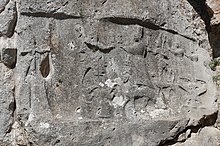 Global Information
Global InformationTeshub information
| Teshub | |
|---|---|
Weather god, king of the gods | |
 A relief from Yazılıkaya depicting Teshub (left), Ḫepat and their children and servants. | |
| Major cult center | Kumme, Arrapha, Aleppo, Kaḫat, Kummanni |
| Weapon | weather phenomena |
| Animals | bull |
| Mount | chariot pulled by Šeri and Ḫurri |
| Personal information | |
| Parents | Anu and Kumarbi |
| Siblings | Šauška, Tašmišu, Aranzaḫ |
| Spouse | Ḫepat |
| Children | Šarruma, Allanzu, Kunzišalli |
| Equivalents | |
| Mesopotamian equivalent | Adad |
| Ugaritic equivalent | Baal |
| Hittite equivalent | Tarḫunna |
| Luwian equivalent | Tarḫunz |
| Urartian equivalent | Teišeba |
Teshub was the Hurrian weather god, as well as the head of the Hurrian pantheon. The etymology of his name is uncertain, though it is agreed it can be classified as linguistically Hurrian. Both phonetic and logographic writings are attested. As a deity associated with the weather, Teshub could be portrayed both as destructive and protective. Individual weather phenomena, including winds, lightning, thunder and rain, could be described as his weapons. He was also believed to enable the growth of vegetation and create rivers and springs. His high position in Hurrian religion reflected the widespread importance of weather gods in northern Mesopotamia and nearby areas, where in contrast with the south agriculture relied primarily on rainfall rather than irrigation. It was believed that his authority extended to both mortal and other gods, both on earth and in heaven. However, the sea and the underworld were not under his control. Depictions of Teshub are rare, though it is agreed he was typically portrayed as an armed, bearded figure, sometimes holding a bundle of lightning. One such example is known from Yazılıkaya. In some cases, he was depicted driving in a chariot drawn by two sacred bulls.
According to Song of Emergence, Teshub was born from the split skull of Kumarbi after he bit off the genitals of Anu during a conflict over kingship. This tradition is also referenced in other sources, including a hymn from Aleppo and a Luwian inscription. A single isolated reference to the moon god Kušuḫ being his father instead is also known. In individual texts various deities could be referred to as his siblings, including Šauška, Tašmišu and Aranzaḫ. His wife was Ḫepat, a goddess originally worshipped in Aleppo at some point incorporated into the Hurrian pantheon. Their children were Šarruma, Allanzu and Kunzišalli. Other deities believed to belong to the court of Teshub included Tenu, Pentikalli, the bulls Šeri and Ḫurri and the mountain gods Namni and Ḫazzi. Members of his entourage were typically enumerated in so-called kaluti, Hurrian offering lists. God lists indicate that Teshub could be recognized as the equivalent of other weather gods worshipped in Mesopotamia and further west in Syria, including Adad and Ugaritic Baal. In Anatolia he also influenced Hittite Tarḫunna and Luwian Tarḫunz, though all of these gods were also worshipped separately from each other.
The worship of Teshub is first attested in the Ur III period, with the early evidence including Hurrian theophoric names and in a royal inscription from Urkesh. Later sources indicate that his main cult center was the city of Kumme, which has not yet been located with certainty. His other major sacred city was Arrapha, the capital of an eponymous kingdom located in the proximity of modern Kirkuk in Iraq. Both of these cities were regarded as religious centers of supraregional significance, and a number of references to Mesopotamian rulers occasionally sending offerings to them are known. In the Mitanni empire, the main site associated with him was Kaḫat in northern Syria. In Kizzuwatna in southeastern Turkey he was worshipped in Kummanni. Furthermore, due to Hurrian cultural influence he came to be viewed as the weather god of Aleppo. He was also worshipped in many other Hurrian cities, and in the second half of the second millennium BCE he was the deity most commonly invoked in Hurrian theophoric names, with numerous examples identified in texts from Nuzi. He is also attested as a commonly worshipped deity in the Ugaritic texts, which indicate that Hurrian and local elements were interconnected in the religious practice of this city. Additionally, he was incorporated into Hittite religion and Luwian religion. His hypostasis associated with Aleppo attained particular importance in this context.
Multiple Hurrian myths focused on Teshub are known. Most of them are preserved in Hittite translations, though the events described in them reflect Hurrian, rather than Hittite, theology. Many of them focus on Teshub's rise to the position of the king of the gods and his conflict with Kumarbi and his allies, such as the sea monster Ḫedammu, the stone giant Ullikummi or the personified sea. These texts are conventionally referred to as the Kumarbi Cycle, though it has been pointed out that Teshub is effectively the main character in all of them, leading to occasional renaming proposals. Teshub is also a major character in the Song of Release, whose plot focuses on his efforts to secure the liberation of the inhabitants of Igingalliš from Ebla. Two of the preserved passages additionally deal with his meetings with Ishara, the tutelary goddess of the latter city, and Allani, the queen of the underworld. Interpretation of the narrative as a whole and its individual episodes remain matters of scholarly debate. Additional references to him have been identified in a number of literary texts focused on human heroes, including the tale of Appu and the Hurrian adaptation of the Epic of Gilgamesh.